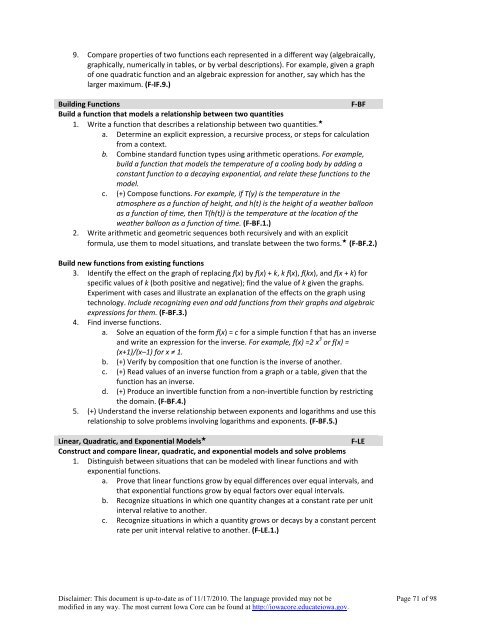Iowa Core K-12 Mathematics (PDF) - Green Hills AEA
Iowa Core K-12 Mathematics (PDF) - Green Hills AEA
Iowa Core K-12 Mathematics (PDF) - Green Hills AEA
You also want an ePaper? Increase the reach of your titles
YUMPU automatically turns print PDFs into web optimized ePapers that Google loves.
9. Compare properties of two functions each represented in a different way (algebraically,<br />
graphically, numerically in tables, or by verbal descriptions). For example, given a graph<br />
of one quadratic function and an algebraic expression for another, say which has the<br />
larger maximum. (F-IF.9.)<br />
Building Functions<br />
F-BF<br />
Build a function that models a relationship between two quantities<br />
1. Write a function that describes a relationship between two quantities. ★<br />
a. Determine an explicit expression, a recursive process, or steps for calculation<br />
from a context.<br />
b. Combine standard function types using arithmetic operations. For example,<br />
build a function that models the temperature of a cooling body by adding a<br />
constant function to a decaying exponential, and relate these functions to the<br />
model.<br />
c. (+) Compose functions. For example, if T(y) is the temperature in the<br />
atmosphere as a function of height, and h(t) is the height of a weather balloon<br />
as a function of time, then T(h(t)) is the temperature at the location of the<br />
weather balloon as a function of time. (F-BF.1.)<br />
2. Write arithmetic and geometric sequences both recursively and with an explicit<br />
formula, use them to model situations, and translate between the two forms. ★ (F-BF.2.)<br />
Build new functions from existing functions<br />
3. Identify the effect on the graph of replacing f(x) by f(x) + k, k f(x), f(kx), and f(x + k) for<br />
specific values of k (both positive and negative); find the value of k given the graphs.<br />
Experiment with cases and illustrate an explanation of the effects on the graph using<br />
technology. Include recognizing even and odd functions from their graphs and algebraic<br />
expressions for them. (F-BF.3.)<br />
4. Find inverse functions.<br />
a. Solve an equation of the form f(x) = c for a simple function f that has an inverse<br />
and write an expression for the inverse. For example, f(x) =2 x 3 or f(x) =<br />
(x+1)/(x–1) for x ≠ 1.<br />
b. (+) Verify by composition that one function is the inverse of another.<br />
c. (+) Read values of an inverse function from a graph or a table, given that the<br />
function has an inverse.<br />
d. (+) Produce an invertible function from a non-invertible function by restricting<br />
the domain. (F-BF.4.)<br />
5. (+) Understand the inverse relationship between exponents and logarithms and use this<br />
relationship to solve problems involving logarithms and exponents. (F-BF.5.)<br />
Linear, Quadratic, and Exponential Models ★<br />
F-LE<br />
Construct and compare linear, quadratic, and exponential models and solve problems<br />
1. Distinguish between situations that can be modeled with linear functions and with<br />
exponential functions.<br />
a. Prove that linear functions grow by equal differences over equal intervals, and<br />
that exponential functions grow by equal factors over equal intervals.<br />
b. Recognize situations in which one quantity changes at a constant rate per unit<br />
interval relative to another.<br />
c. Recognize situations in which a quantity grows or decays by a constant percent<br />
rate per unit interval relative to another. (F-LE.1.)<br />
Disclaimer: This document is up-to-date as of 11/17/2010. The language provided may not be Page 71 of 98<br />
modified in any way. The most current <strong>Iowa</strong> <strong>Core</strong> can be found at http://iowacore.educateiowa.gov.
















